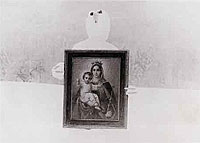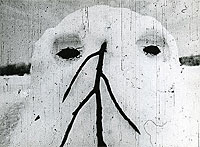 Hungary, 1969, colour, 16 mins.
Hungary, 1969, colour, 16 mins.
Ostensibly a non-narrative study of various aspects of a rural winter, this short film by one of modern Hungarian cinema’s greatest visual poets has all the spellbinding qualities of his better-known feature debut Sindbad (Szindbád, 1971), but here allied to a winning sense of humour that’s never quite allowed to detract from the haunting beauty of many of the images. The end of autumn is heralded by a few red leaves still clinging to a statue’s sculpted robes, while whip pans across the increasingly wintry landscape and close-ups of rippling water are given character by seemingly random freeze-frames and Zoltán Jeney’s electronic chirrups on the soundtrack. There are recurring shots of birds, migrating en masse, huddled by the icy water or lying individually dead, frozen stiff in the snow. So far Capriccio has been a reasonably generic mood piece, but then the snowmen arrive.

We briefly see one of them being constructed by snowball-throwing children, but the origin of most of the snowmen is a complete mystery. Some sport antlers, others candelabra, they’re decked out in military or religious accoutrements, hold portraits or musical instruments. A whole semicircle of snowmen forms a brass band, while a top-hatted colleague is waited upon by semi-nude women dressed as angels. One lies on a funeral bier, surrounded by candles, another in a hospital bed that’s been set up on an ice sheet. Another has a real human skull where its heart would normally be. Yet another has its entire chest region occupied by a wire cage full of living birds, while another has perspex-encased beetles for eyes, to make a change from the usual carrots and corn-cobs standing in for facial features.
Very funny though much of this is, Huszárik never forgets the film’s primary purpose, which is to emphasise the fleeting evanescence of not just the seasons but also living creatures within it: the snowmen might as well be us ourselves, mere blips in a timeline lasting millennia. A collection of snow homunculi reminiscent of Anthony Gormley’s Field for the British Isles (one sporting real glasses) melts in seconds with the assistance of time-lapse cinematography. Soon everything has melted, droplets of water drip off branches, and grass starts growing to herald the arrival of spring. and the cycle begins anew.
- Director: Zoltán Huszárik
- Screenplay: Zoltán Huszárik, János Tóth
- Photography: János Tóth
- Editing: János Tóth
- Sound: György Pintér
- Music: Zoltán Jeney
- Consultants: Elek Bajkovszky, János Réti, Hajnal Sellő
- Producer: Jenő Götz, Péter Magyar
- Production Company: Béla Balázs Studio
Links
- The Béla Balázs Studio website entry includes a video extract (no spoken dialogue).
- Internet Movie Database